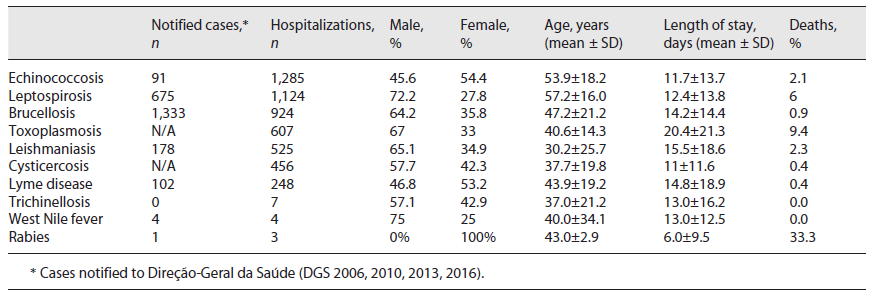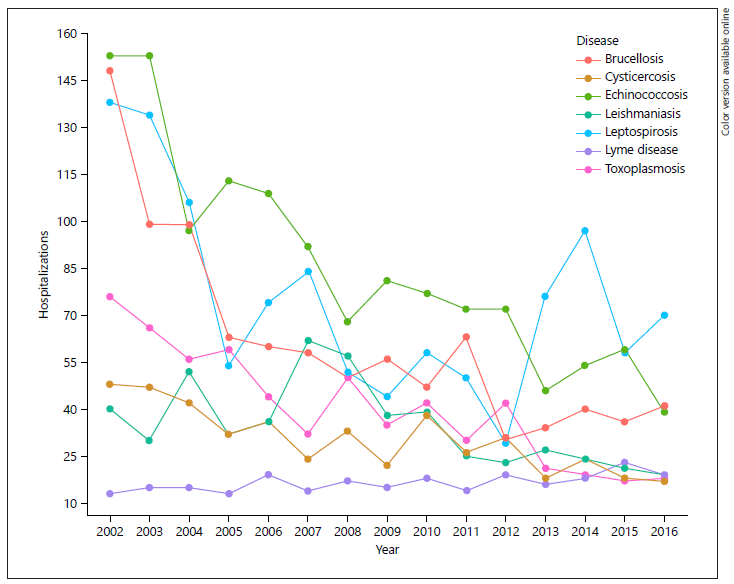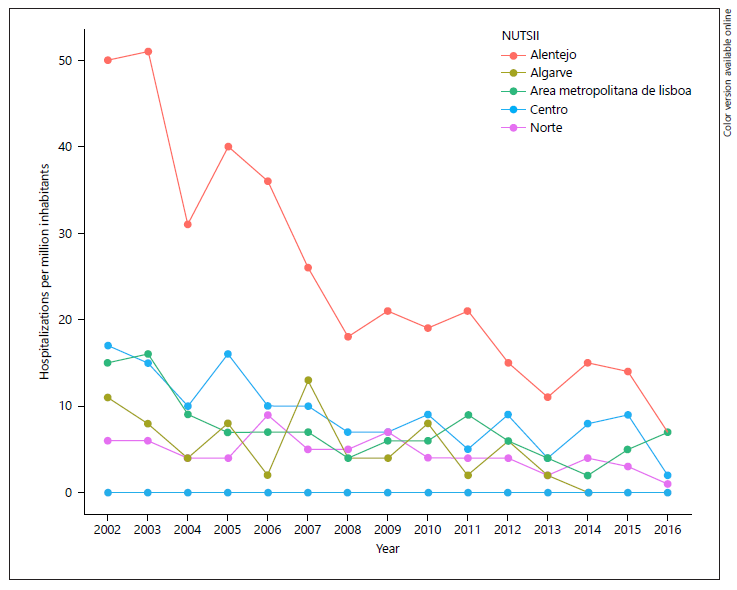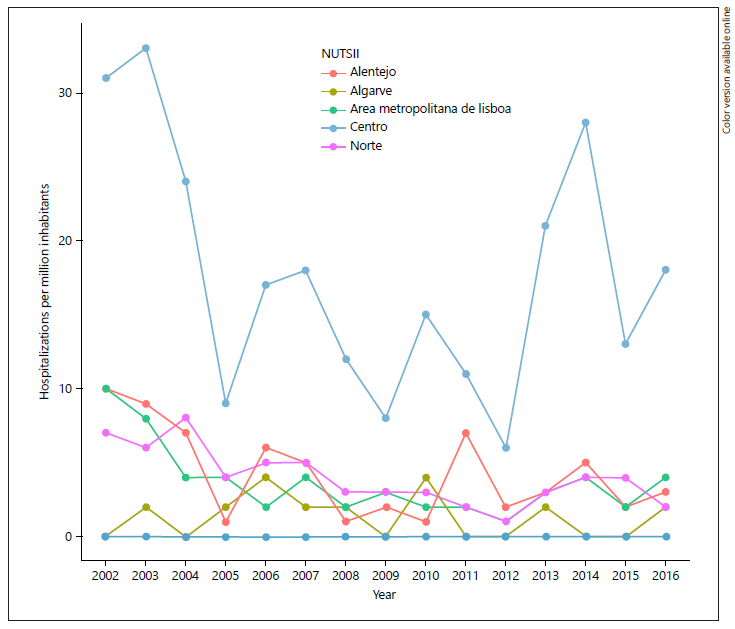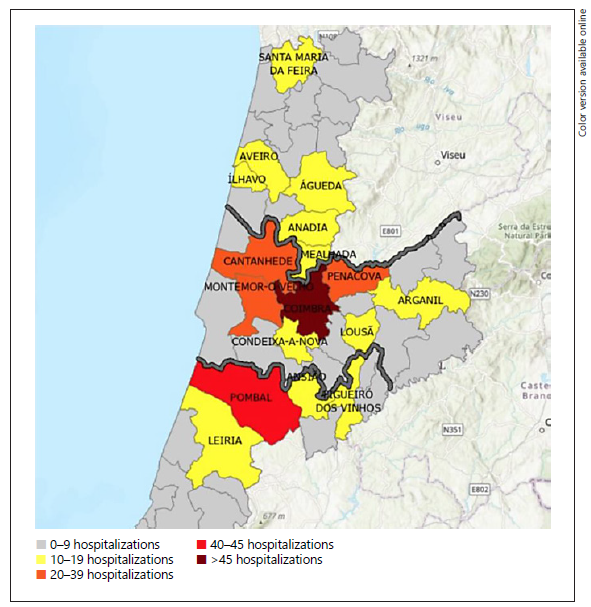Introduction
It is estimated that around 62% of the known human pathogens have an animal origin 1 and that 75% of emerging human diseases since the second half of the 20th century have originated in animals 2. Diseases or infections transmitted between vertebrates and humans are called zoonoses, and these can be caused by bacteria, viruses, fungi, or parasites 3. This transmission is made possible through contact between humans and animals, whether it occurs at home, on farms, in zoological parks, in nature, markets, or through the handling and ingestion of animal products without adequate hygienic and sanitary care 4. The conversion of wild habitats into agricultural fields and pasture enables the contact between wildlife and livestock, increasing the likelihood of pathogen transmission; these pathogens then have a greater chance of being transmitted to humans 5. The increased global movement of humans, animals, and animal products has also contributed to the spread of established and emerging zoonoses 6. Some zoonoses have the potential to evolve into epidemics and pandemics, with impacts on the health of millions of people difficult to completely grasp 7. These diseases are also impactful in economic terms: combined, bovine spongiform encephalopathy (BSE), severe acute respiratory syndrome (SARS), and infections caused by the H1N1 and H5N1 subtypes of influenza A have caused an estimated direct global economic impact of 20 billion United States Dollars and 200 billion United States Dollars in indirect losses 8.
The permanent threat to health and well-being posed by diseases capable of transposing the human-animal barrier is even clearer in the period in which we currently live, under the restrictions to normal life imposed by the COVID-19 (Coronavirus disease 2019) pandemic. It is important to recognize, however, that it is not only zoonoses with the potential to reach pandemic proportions that should be the target of research and policymaking. Diseases such as rabies, tuberculosis, brucellosis, and echinococcosis are responsible for high mortality and morbidities, especially in socioeconomically disadvantaged populations 8. Several zoonoses have the human-to-human route of transmission as the most relevant means of spreading, as is the case in both the current severe acute respiratory syndrome Coronavirus 2 and in the two previous influenza A virus pandemics. Human-to-human transmission is also the most important pathway for the spread of tuberculosis, with only 1.4% of human cases having a zoonotic origin 9.
In the 1960s, the complementarity between human and veterinary medicines was recognized under the concept of One Medicine, with the implication that the interdisciplinary exchange of information between the two disciplines was key to their development 10. From this initial idea, a broader concept of One Health emerged, framing the interdependence of Animal and Human Health with the Environment that surrounds them 11. These concepts lack further implementation in Portugal. In addition to medical doctors and other professionals working directly in human health, veterinarians and especially the Official Veterinary Services are key figures in the defense of Public Health. Collaboration between physicians and veterinarians is essential, with professionals from both areas having crucial roles in the interdisciplinary network working toward a healthy and stable Human-Animal-Environment Interface. These include creating disease prevention, control, and eradication protocols; epidemiological vigilance networks; informing governmental policy; and promoting communication between local, national, and international stakeholders.
We set out to investigate and characterize the hospitalizations in Portuguese National Health Service (NHS) hospitals caused by zoonoses in which the animal-human transmission route is the most relevant: brucellosis, cysticercosis, echinococcosis, leishmaniasis, leptospirosis, Lyme disease, rabies, toxoplasmosis, trichinellosis, and West Nile fever. All of these, except for cysticercosis and toxoplasmosis, are Mandatory Notification Diseases. A better understanding of the hospitalizations caused by these zoonoses will allow for the enhancement of information available to decision-makers, and enable the development of new and better global health policies by the official health services.
Objectives
The severity of diseases caused by zoonotic infections in humans is variable. The main contribution of this study is the promotion of a better understanding of the evolution of zoonotic diseases that manifest critically in humans - requiring hospital admissions - in 21st century Portugal. The specific objectives were as follows:
Characterize the hospitalizations caused by zoonoses between 2002 and 2016 regarding gender, age, year, length of stay, region, and mortality.
Characterize the hospitalizations that had one of the selected zoonoses (brucellosis, cysticercosis, echinococcosis, leishmaniasis, leptospirosis, Lyme disease, rabies, toxoplasmosis, trichinellosis, and West Nile fever) as the main cause of admission, regarding gender, age, year, length of stay, region, and mortality.
Materials and Methods
A retrospective nationwide study was conducted using a database that gathers hospitalization information from all Portuguese public hospitals, obtained from Administração Central do Sistema de Saúde (ACSS). Data from 2002 to 2016 regarding the year of hospitalization, hospital, gender, date of birth, district, council and municipality of residence, date of hospitalization, date of discharge, length of stay, outcome, and the 20 variables that codified different diagnoses made in each patient were analyzed. Each entry corresponds to hospital admission, which means that a single patient can be considered multiple times if he/she has been hospitalized more than once. Diagnoses are coded by trained medical doctors using the International Classification of Diseases - 9th Revision. The database is frequently audited by external referees, ensuring high standards, and identifying and correcting existing errors. The data are anonymized. The period from 2002 to 2016 corresponds to the years in which the data were already validated by ACSS.
Age was categorized into 10 classes (<10, 10-17, 18-25, 26-35, 36-45, 46-55, 56-65, 66-75, 76-85, and >85), and the country was geographically organized using Nomenclature of Territorial Units for Statistics II (NUTS II) regions - Alentejo, Algarve, Área Metropolitana de Lisboa, Centro, Norte, Madeira, and Açores. To characterize the hospitalizations recorded between 2002 and 2016, hospitalizations in which at least one zoonosis was registered as a diagnosis were selected from the initial 14,507,367. This first selection resulted in a database with 881,345 entries. Within these, we selected those in which the main cause of admission was a zoonosis, resulting in 181,741 records. To focus the study on diseases in which the animal-human route of transmission is the most significant, hospitalizations caused by the following zoonoses were selected: brucellosis, cysticercosis, echinococcosis, leishmaniasis, leptospirosis, Lyme disease, rabies, toxoplasmosis, trichinellosis, and West Nile fever. This selection resulted from the final database with a total of 5,183 hospitalizations (shown in Fig. 1). This selection excluded diseases in which the human infection may have had an origin other than animals, namely tuberculosis, Creutzfeldt-Jakob disease, and influenza.
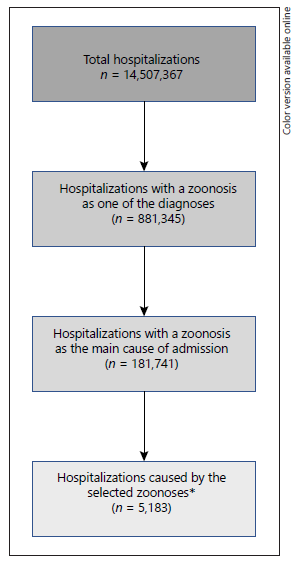
Fig. 1 Sample flowchart. *Selected zoonoses were brucellosis, cysticercosis, echinococcosis, leishmaniasis, leptospirosis, Lyme disease, rabies, toxoplasmosis, trichinellosis, and West Nile fever.
For each of the selected diseases, presented by descending order of several hospitalizations, we performed a descriptive characterization of hospitalizations by year, evaluating the absolute and relative frequencies stratified by sex, age group, duration of hospitalization, NUTS II, and district of residence. For the NUTS II and districts with a mean hospitalization percentage greater than four times that of the remaining areas, we investigated the most affected counties. Due to the reduced number of hospitalizations caused by rabies, trichinellosis, and West Nile fever, all of which with less than 10, a detailed descriptive analysis was not carried out.
To provide more contextualized analyses considering different population dimensions, absolute frequencies per million inhabitants were computed by region. The populational information used was gathered from Census 2011, provided by the National Institute of Statistics, determining the number of inhabitants in each area (NUTS II or district). The number of hospitalizations per region was divided by population size in each area and then multiplied by 1,000,000.
The analysis was accompanied by a graphical exploration that enabled the evaluation of case fluctuations throughout the years for each variable, as well as the overall monthly hospitalization incidence. Every analysis was performed using the program R - RStudio Version 1.2.5033 Interface © 2009-2019 RStudio, Inc. Presented maps were created with ArcGIS Pro Version 2.5 © 2020 ESRI, Inc.
Results
Between 2002 and 2016, 14,507,367 hospitalizations were registered in mainland Portugal’s NHS hospitals. Zoonoses were registered as the main cause of admission 181,741 times (1.25% of the total hospitalizations). These 181,741 hospitalizations encompass all zoonoses, including those transmitted mainly through the human-to-human route (e.g., tuberculosis).
Characterization of hospitalizations with Zoonoses as the main cause of admission
Of the 181,741 hospitalizations caused by zoonoses, 96,320 (53%) were male and 85,419 (47%) female patients. The mean age was 42.5 ± 31.5 years, with a minimum of 0 and a maximum of 109 years. The total number of hospitalization days was 2,033,125, and death was the outcome in 10,611 (5.8%) cases. In Table 1, we present the diseases responsible for the greatest number of hospitalizations, with the majority being caused by pathogens with possible alternative origins other than animals.
Characterization of hospitalizations with the selected zoonoses as the main cause of admission
In the database, 5,183 hospitalizations were recorded as having one of the selected zoonoses as the main cause of admission, with 3,126 (60.3%) of these being male and 2,057 (39.7%) female patients. The mean age was 47.5 ± 20.9 years, with a minimum of 0 and a maximum of 98 years. Death was the outcome in 176 (3.4%) cases.
Table 2 presents a summary of the results. The total number of hospitalization days was 71,548. Figure 2 represents the evolution of each disease throughout the study period.
Echinococcosis caused the greatest number of hospitalizations. Adult patients represented 96.3% of hospitalizations. In Figure 3, we describe the distribution of hospitalizations caused by echinococcosis by region of residence per million inhabitants, where it is possible to verify that this disease has special relevance in the Alentejo region.
Leptospirosis showed the biggest difference between genders: 72.2% of male and 27.8% of female hospitalizations. Adult patients represented 98.4% of the total cases. In Figure 4, we present the evolution of the number of leptospirosis hospitalizations pondered by the size of the population in each region. The Centro region stands out with the largest number of cases. It is possible to observe the case distribution in the Aveiro, Coimbra, and Leiria districts in Figure 5.
Brucellosis was the only disease exhibiting a distinctive monthly trend, with an increased number of hospitalizations between May and August and had its highest impact in the Norte and Centro regions. Males represented 64.2% of total hospitalizations. Regarding toxoplasmosis, adult hospitalizations represented 96.4% of the total. It had the longest average hospitalization length, with 20.4 ± 21.3 days, as well as the highest death percentage (9.4%); seventy per cent of cases showed cerebral involvement, 5.3% affected the eyes, 3.8% showed multisystemic dissemination of the parasite, and other forms represented 21.4% of hospitalizations. Leishmaniasis had the lowest age average, mainly affecting the <10 years old group, with the visceral form of the disease representing 84% of hospitalizations. Cysticercosis had its greatest impact in Área Metropolitana de Lisboa. Lyme disease was the only studied zoonosis with a slight trend of increasing hospitalizations in mainland Portugal between 2002 and 2016, especially in the Norte region.
Seven hospitalizations caused by trichinellosis were registered in the study period and four had West Nile fever as the reason for admission. Three hospitalizations were attributed to rabies: two of them represent the transfer between hospitals of 1 patient, who died after 17 days, and the other patient got discharged after 1 day.
Discussion
In mainland Portugal’s NHS hospitals, between 2002 and 2016, zoonotic diseases were the main cause of admission in 1.25% of all registered hospitalizations. In this group are included all diseases with potential, but unconfirmed, animal origin; these include infections by Escherichia coli, Salmonella spp., Staphylococcus spp., Streptococcus spp., Rickettsia spp., and Mycobacterium spp. Within zoonosis-induced hospitalizations, we only selected for detailed analysis those in which it was possible to confirm that the human infection had an animal origin. It was not possible to confirm that hospitalizations caused by Creutzfeldt-Jakob disease and tuberculosis, for example, were associated with bovine spongiform encephalopathy and with contact with infected animals, respectively; for that reason, these types of diseases were not included in the subsequent analysis.
Leishmaniasis was the disease that affected minors the most, especially children under 10 years old. Lack of previous exposure to the agent and immature innate immunity can explain this age group’s greater susceptibility to disease in comparison to immunocompetent adults. Also, children have greater exposure to the agent (in this case present in a vector), when compared to diseases like leptospirosis and echinococcosis; in these diseases, the risk groups tend to be people with greater contact with animals, such as shepherds and farm, warehouse and slaughterhouse workers 12,13. These latter zoonoses, generally more severe, present the biggest proportions of adult hospitalizations, with 98.4% and 96.3%, respectively, along with toxoplasmosis (96.4%).
Except for brucellosis, in which we observed an increased number of hospitalizations between May and August, the diseases under study presented heterogenous monthly distributions with no clear patterns of hospitalization throughout the year. This fact is understandable for zoonoses like echinococcosis and cysticercosis, in which: (1) due to the lifecycle of the parasites involved, the infection can occur at any time of the year, and (2) the diseases are characterized by chronic evolution. For these reasons, a correlation is not expected to exist between the moment of infection and the appearance of symptoms and consequent hospitalization. However, it is essential to note that because of the low number of hospitalizations in most of the studied diseases, it is difficult that the real seasonal patterns of incidence to translate into the distribution of hospitalizations. This monthly pattern of hospitalizations caused by brucellosis is by what is described in the literature relative to the incidence of the disease 14,15,16,17, explained by the increased contact with infectious materials in farms connected to the dairy industry in these times of the year, namely, materials resulting from abortions, such as secretions and fetuses 18. Also, by previous studies 14, 19, a larger proportion of brucellosis-induced hospitalizations of male patients (64.2%) was recorded in Portugal. A possible explanation is the greater exposure of males to the pathogen, in line with the predominance of men in activities that involve closer contact with infected animals 14,20.
Echinococcosis is a good example of a disease that has a noteworthy regional impact, which, in this study, was only possible to observe when considering the size of the population by region. With a similar presence in the various regions, echinococcosis has greater importance in Alentejo because of its relatively sparse population. The prevalence of this disease has been viewed as a public health threat in the region for some decades 21-23. Although a diminishing impact has been observed in humans, it is important to note that between 1979 and 2008, only 646 official human cases were reported in Portugal 24 and only 91 between 2002 and 2016 25-28. Even considering that the present work measures hospitalizations and not cases of the disease, the fact that in this study alone there were 1,285 registered hospitalizations caused by echinococcosis suggests that there is an insufficient notification of cases to central authorities and also poor communication between state agencies, namely, ACSS and Direção-Geral da Saúde (Directorate-General of Health). Also, for leptospirosis, leishmaniasis, Lyme disease, trichinellosis, and rabies, all of which are Mandatory Notification Diseases 29, there seems to be an insufficient notification to health authorities when considering the number of hospitalizations observed in this study (Table 2). Brucellosis, with more hospitalizations in the Norte and Centro regions, is the only studied Mandatory Notification Disease that has more notified cases than the number of hospitalizations evidenced in this work.
Lyme disease, an emerging disease in Portugal and Europe 30 caused more hospitalizations in the Norte region. It is essential to establish good epidemiological vigilance networks for this zoonosis, which has the potential to become more prevalent in Portugal, being the only one with a slight trend of increasing hospitalization episodes during the study period, likely related to a larger incidence in the population.
West Nile fever has also been increasingly reported in humans, horses, and the vectors themselves 28,31,32. With the virus and the vector already established in the country 33, having active epidemiological vigilance and action is essential to prevent and control outbreaks of the disease in Portugal, minimizing the rise of cases already detected in other parts of Europe. The cases of rabies, on the other hand, were imported from outside the country, as the disease is absent from wild and domestic animals in Portugal.
Leptospirosis was revealed to be an important zoonosis in the Centro region, both in absolute terms, as well as when accounting for the size of the population. This tendency had already been described 34. In the region, the districts with the greatest number of hospitalizations were Coimbra, Aveiro, and Leiria. In the Aveiro and Leiria districts, it is interesting to note that the majority of cases occurred in the counties closest to the Coimbra district (shown in Fig. 4). For this zoonosis, the one that showed the highest age average, we observe a big increase in hospitalizations in 2013 and 2014, caused by a higher number of admittances in the Centro region.
However, the highest average in days of hospitalization is “toxoplasmosis,” which also presented the highest death percentage of all the studied diseases: 9.4%. Toxoplasmosis can cause serious illness in immunocompromised individuals, such as those with acquired immunodeficiency syndrome. Its severity in Portugal is what would be expected, in that which is the second most death-causing food-related infection in the USA 35. However, the ten diseases have had, as a whole, a significant impact on Public Health in Portugal, causing 71,548 hospitalization days.
The strength of this work comes from its wide coverage, using data collected at a nationwide level for 15 years, composed of complete information, including days of hospitalization and its outcome, with records being carried out by doctors in a hospital context. Nevertheless, the study presents some limitations, namely, by using secondary data which encompasses only mainland Portugal’s public hospitals, by not considering other relevant variables like the availability of better primary healthcare and of better treatments that can reduce the need for hospitalization, and because there may not be a direct relationship between the number of hospitalizations and the incidence of disease in the population.
It becomes clear that a trend of decreasing hospitalizations of human patients has accompanied the reduction of animal cases of these diseases 36. The zoonoses’ combat measures implemented in Portugal by Direção-Geral de Alimentação e Veterinária (Directorate-General of Food and Veterinary) and a better education of the population, which have caused a decreased incidence in animals, have also likely had implications on the decreased transmission to humans and consequent hospitalizations.
Conclusion
It is essential to highlight several points addressed in this work. It was possible to attest that zoonoses, before the COVID-19 pandemic, were already important factors causing human hospital admissions. Between 2002 and 2016, zoonoses, in general, have caused 181,741 hospitalizations, a total number of hospitalization days of 2,033,125, and 10,611 deaths. Those which have an unquestionable animal origin have caused 5,183 hospitalizations, 71,548 hospitalization days, and 176 deaths. The majority of these diseases showed a higher number of cases in male individuals, a tendency that was not observed only for echinococcosis and Lyme disease.
Heterogeneous spatial distribution of the different diseases was observed within the national territory. We can also note the persistence of the traditional importance of echinococcosis in Alentejo, as well as the increasing impact of leptospirosis in the Centro region. Nevertheless, the frequency of these hospitalizations has been decreasing since the beginning of this century. On top of a more direct impact medical doctors and other health professionals might have, this decline is also due to the work veterinarians have been executing in the control of these diseases (i.e., rabies and leptospirosis vaccines). Through the development and implementation of epidemiological vigilance plans, the employment of technical procedures necessary to the control of these zoonoses (prophylaxis and treatment) and the education of the population, both animal and human health professionals are doing their part in the fight against these threats to Public Health.
Some diseases, however, are growing threats to human and animal health. Examples of these are West Nile fever and Lyme disease. For an adequate control and management of the emerging challenges and threats to public health that will continue to arise in the country and the world, it is essential to further develop multidisciplinary and trans professional strategies focused on the One Health principles.
Acknowledgments
The authors thank Administração Central do Sistema de Saúde (ACSS) for making the data used in this study available to science.














